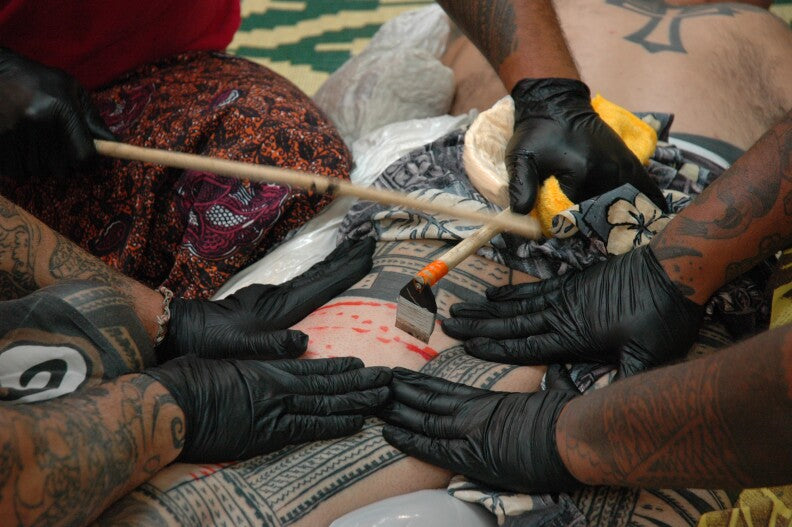Polynesian tattoos are more than just body art — they’re a visual language, a deeply symbolic system of identity, status, protection, and genealogy. Passed down through centuries, these designs hold cultural and spiritual meaning that connects the wearer to their ancestry and environment.
From the intricate Samoan tattoo designs to striking Polynesian leg tattoos, each line, curve, and shape tells a story. In this blog, we’ll explore the key Polynesian tattoo symbols, their meanings, cultural origins, and how modern interpretations are blending tradition with contemporary art.
A Brief History of Polynesian Tattooing
The word “tattoo” itself comes from the Polynesian word tatau, reflecting the deep historical roots of body art in the region. Polynesian societies—like the Samoans, Maori, Hawaiians, and Marquesans—developed tattooing as a sacred rite of passage.
Historically, tattoos were used to:
- Indicate social status or leadership
- Commemorate life achievements or battles
- Represent spiritual protection
- Reflect one’s family lineage
Traditional tattooing was done using sharpened bone or wood combs, dipped in ink made from burned coconut shells. The process was long, painful, and deeply ceremonial.
Understanding Polynesian Tattoo Symbols
Each Polynesian tattoo symbol is loaded with meaning. Let’s break down some of the most common motifs you’ll find in Polynesian tattoo designs:
a. Shark Teeth (Niho Mano)
- Symbolizes protection, guidance, and strength
- Often used in warrior tattoos
- Seen frequently in Polynesian tribal designs
b. Turtle Shell (Honu)
- Represents family, longevity, and peace
- A sacred animal in Polynesian culture

c. Spearheads
- Symbol of courage and warrior spirit
- Used in patterns to signify readiness to fight
d. Ocean Waves
- Symbolize change, travel, and the spiritual connection to water
- Popular in Polynesian leg tattoos or shoulder pieces
e. Enata (Human Figures)
- Represent people, gods, or ancestors
- Often grouped to tell stories of lineage or community
Each symbol may look simple, but their placement, size, and direction greatly affect their meaning.
Regional Styles Within Polynesia
Polynesian tattooing isn’t monolithic — each island culture has developed its own style:
Samoan Tattoos (Pe'a and Malu)
- Full-body pieces for men (Pe’a) and women (Malu)
- Highly structured, symmetrical patterns
- Considered a rite of passage for adulthood
Hawaiian Tattoos
- Focus more on geometric patterns and nature
- Hawaiian leg tattoos and hand tattoos are especially symbolic
- Common symbols: taro leaves, waves, lizards

Maori Tattoos (Ta Moko)
- Focus on spiral patterns, especially on the face
- Represent ancestry and personal identity

Marquesan Tattoos
- Denser patterns, combining multiple symbols
- Full sleeves and Polynesian hand tattoos are common

Modern Polynesian Tattoo Designs: Fusion and Evolution
While traditional methods are still practiced in some areas, modern tattoo artists are bringing Polynesian tribal tattoos to new audiences.
Today’s Polynesian tattoo designs are:
- Often done using rotary or wireless tattoo machines
- Customized to combine personal meaning + cultural accuracy
- Blended with realism, dotwork, or minimalist styles
However, respectful use is crucial. Tattoo artists and clients must educate themselves to avoid cultural appropriation — using symbols without understanding or connection can be offensive.
Popular Polynesian Tattoo Ideas
Looking for Polynesian tattoo ideas? Here are some concepts that combine beauty, meaning, and cultural significance:
| Design Idea | Symbol Focus |
|---|---|
| Full Leg Sleeve | Waves, spearheads, turtles (strength + change) |
| Half-Sleeve Tribal Design | Shark teeth + enata (warrior & family) |
| Back Piece for Women | Turtle shell + geometric flowers |
| Polynesian Hand Tattoo | Small symmetrical symbols (protection) |
| Samoan-Inspired Chest Piece | Linear symmetry, layered meanings |
When designing your own piece, consider working with an artist experienced in Polynesian tribal design who can help match symbols to your personal story.
Placement Matters: Meaning by Location
Placement plays a huge role in traditional Polynesian tattoos:
| Body Part | Cultural Meaning |
|---|---|
| Legs | Travel, movement, life journey |
| Arms/Shoulders | Strength, responsibility, connection to tribe |
| Back | Legacy, support from ancestors |
| Hands | Creativity, craft, giving |
| Face (in Maori culture) | Identity, genealogy, social rank |
In modern designs, Polynesian leg tattoos and hand tattoos are among the most requested due to their visibility and symbolic weight.
Designing Your Polynesian Tattoo Responsibly
A Polynesian tattoo is not just a fashion statement — it’s a spiritual and cultural legacy.
Tips for responsible tattooing:
- Research the symbols before choosing them
- Consult Polynesian artists or cultural advisors if possible
- Avoid mixing styles (e.g., Polynesian + Japanese) unless you understand both
- Tell your story through the design — don’t just copy one off Pinterest
Conclusion: Wearing Culture with Respect
Whether you're drawn to Polynesian tribal tattoos for their visual strength or ancestral power, remember: every line has meaning. Polynesian tattoo symbols are rooted in a history of resilience, pride, and identity — and wearing them should be a reflection of that.
If you choose to get a Polynesian tattoo, take time to understand its story, collaborate with a skilled artist, and wear your ink not just on your skin, but in your heart.









Share:
Ancient Tattoos: What Mummies Can Teach Us About Ink
The History of American Traditional Tattoo: Timeless Ink with Bold Roots